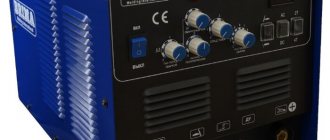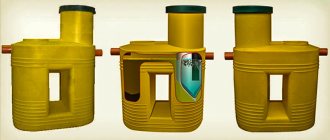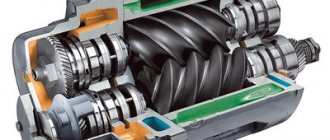To find out how to charge an alkaline battery at home, you need to study the features of such devices. The battery contains an electrolyte - an aqueous solution of sodium or potassium hydroxide. The charging process is accompanied by a number of chemical reactions.
Alkaline battery voltage.
Advantages and disadvantages
Alkaline batteries differ in:
- Long service life with proper maintenance;
- They have a relatively small weight and size;
- Positioned with a small spontaneous discharge;
- Stable operation in conditions of negative t0.
Note! When the negative t0 indicators drop below – 250C, the capacity of the alkaline battery decreases by one degree and decreases by 0.5%.
Compared to a lead-acid battery, this figure is 2 times higher. Although at low t0, as noted earlier, the capacity indicators are reduced.
The existing disadvantages include an insignificant coefficient of efficiency (efficiency), which, according to various estimates, ranges from 50% to 55%. In comparison, this figure for acid-based batteries is 80%.
In addition, the presence of the memory effect inevitably leads to loss of capacity. It may appear if the charger is not completely discharged.
The wide range of operating voltage of the charging elements is disappointing: 1-1.75 Volts. To set the indicator to 12V, the spread will be 10-17.5 volts. In this case, you cannot avoid using an alkaline battery charger in order to stabilize performance.
On a note. This type of battery should only be serviced by a qualified person. Since, in this case, the electrolyte for alkaline batteries is used, which must be changed periodically.
How to properly replace the electrolyte in an alkaline battery
After every hundredth discharge-charge cycle, it is recommended to replace the alkaline filler. Before starting work, you need to discharge the battery to 1 V.
The liquid contents are removed by turning the housing over. The containers are washed with an alkaline solution or purified water.
Electrolyte for alkaline batteries.
A battery filled with new electrolyte is not immediately installed in the car. After three hours of impregnation, you need to check the level and density of the electrolyte. A battery that has been depleted of filler cannot be stored with the plugs removed.
Alkaline batteries are a common type of energy storage device. An aqueous solution of sodium hydroxide or potassium hydroxide can be used as an electrolyte. Before deciding to use such batteries, it is necessary to study their features and advantages.
Application area
Alkaline batteries can be used as:
- traction;
- and starter devices.
They are installed on mine electric locomotives, locomotives, and passenger cars. Provide different types of alarms and emergency power supply systems.
Indispensable when storing products in warehouses: all kinds of loading machines are equipped with just such batteries. Can be used to start power units (ICE).
The batteries in question are used in portable equipment, home and professional electric tools.
We constantly come into contact with them at home. We turn on the stereo, TV, and use the remote control. Every day we use phones and cameras that use AA batteries as a power source.
It is rare, but common, to use them as starter devices on trucks and military equipment.
Alkaline battery device
Devices operating using an alkaline solution aggregate:
- In combination: nickel/cadmium;
- Or nickel/metal hydride.
In both cases, the positive electrode contains nickel hydroxide (NiOOH) and the addition of graphite and barium oxide, which improve performance.
Graphite has a positive effect on electrical conductivity, increasing it, and barium oxide creates the effect of stable operation.
The photo clearly shows the device of the product in cross-section. It is indicated which components determine the integrity of the battery.
A few words about chemical processes
When discharging, nickel hydroxide + electrode enters into an active reaction with electrolyte ions. This combination produces Ni(OH)2 nickel oxide hydrate.
A similar process occurs at the – electrode. In this case, the formation of hydrates of cadmium and iron oxides occurs. A difference in visible potentials within 1.45 volts is possible by ensuring the process of current flow through the circuits of the internal and external networks. This is the principle of operation of an alkaline battery.
When charging, a reverse chemical process occurs. It is as follows. When current + interacts, the electrodes are oxidized. In this case, nickel oxide hydrate transforms into the hydroxide state of this element. The negative electrode is gradually restored. It produces cadmium and iron.
The peculiarity of the processes taking place: the substances that appear in the process of electrochemical reactions do not enter into chemical relationships with each other, that is, they do not dissolve in the electrolyte.
In this case, electrolyte consumption is not provided. Its density is unchanged: it always remains at the same level.
How to properly replace the electrolyte
Experts recommend replacing the electrolyte every 100-150 cycles.
Before the proposed change in the composition of the electrolyte, it is necessary to discharge the battery to a voltage of 1 volt with normal current.
The spent electrolyte should be drained. In this case, the battery itself must be shaken periodically to remove possible dirt from the container. Then rinse with alkaline or distilled water, shaking vigorously.
The water should have settled by this time. Filling of the new product is carried out immediately. Leave the battery filled with the new composition for about 120 minutes and you can begin measuring the density of the electrolyte. If necessary, bring to the required value and close the lids.
Note! It is not recommended to leave the battery dry after draining the old electrolyte. This can lead to corrosion of the plates!
Electrolyte replacement will be required when switching to operating mode with t0 below 200C.
Characteristics of alkaline batteries
| Battery types | Nominal capacity, Ah | Rated voltage, V | Quantity of electrolyte in liters |
| NK-28 | 28 | 1,25 | 0,27 |
| NZh-22 | 22 | 1,25 | 0,27 |
| NK-55 | 55 | 1,25 | 0,45 |
| NZh-45 | 45 | 1,25 | 0,45 |
| NK-80 | 80 | 1,25 | 0,75 |
| NZh-60 | 60 | 1,25 | 0,75 |
In the symbol, the letters represent the electrochemical system of the battery:
- “NK” - nickel-cadmium;
- “NZH” - nickel-iron;
- The numbers following the letters are the nominal capacity of the batteries, measured in ampere hours.
Design features and fundamental differences of alkaline batteries
The positive electrode, which is part of alkaline car batteries, consists of the hydroxide of a component such as nickel and other elements. The introduction of graphite into the composition has a positive effect on the degree of electrical conductivity. Stability and normal operation are maintained through impurities.
To prepare the negative element, a metal alloy, presented in powder form, nickel or cadmium, is used. In each case, the alkaline battery has its own characteristics.
The electrolyte includes components such as lithium monohydrate, which helps extend the life of the battery.
The following components are also included in the battery:
- An insulation layer consisting of high-quality raw materials.
- Plastic gasket complete with safety valve.
- Housing made of high-strength metal.
- Conclusions.
Ongoing chemical processes
The operating principle of a car alkaline battery is relatively simple. When an alkaline battery is completely discharged, nickel hydroxide reacts with the ions of the alkaline solution. As a result, nickel oxide hydrate is formed. A similar process occurs at the negative terminal. In this case, certain elements are formed.
Read also: How to glue plastic glasses
During charging, a reverse chemical reaction occurs, in which nickel hydroxide is formed and the negative electrode is restored.
Alkaline batteries are popular. After all, they differ from acidic aggregates in that the resulting substances never dissolve and do not react with similar components. In other words, the operating principle of such power supplies is based on certain canons.
Thus, the principle of operation of an alkaline battery is relatively simple.
These power supplies must be fully charged. After all, an incomplete charge helps reduce the period of use. Overcharging the device is not allowed, as this leads to rapid heating and destruction of the electrodes.
Features of electrolyte replacement
The electrolytic composition is replaced at a certain frequency (100-150 cycles). Before replacement, the alkaline battery is discharged at a normal current of up to 1 V.
The used electrolyte is removed carefully. In order to get rid of sediment and dirt, the battery is gently shaken. The device must be washed using distilled water or a solution with a certain amount of alkali.
The electrolyte is poured in immediately after cleaning. The composition should settle for 2-3 hours. Only after this is the density of the poured electrolyte monitored.
The plates and electrodes must not be dry. After all, this can lead to internal corrosion.
Advantages, disadvantages of alkaline power sources
Before using alkaline batteries at home, you need to study their features, pros and cons.
pros
- With timely maintenance and proper use, the service life of the device increases.
- Deep discharge of the unit is allowed.
- Even in severe frosts, the performance of the battery is maintained.
- The amount of self-discharge is minimal. It is very important to choose an alkaline battery charger here.
- The specific gravity of the device is small.
The decrease in capacity with decreasing temperature is minimal. Compared to acid models, alkaline batteries practically do not lose capacity.
Negative sides
- Presence of memory effect. Over time, this provokes a rapid decrease in capacity. Therefore, it is very important to avoid regular undercharging.
- The operating voltage of individual elements has significant differences. Therefore, alkaline batteries must be charged using an efficient unit.
- Alkaline models are characterized by low efficiency.
- Electrolyte replacement and maintenance must be performed by a specialist.
Industries using alkaline batteries
Alkaline reliable batteries are used in many areas. Thus, they are used as starter and traction power sources. They are equipped with:
- Automated alarms, energy saving systems.
- Electrical units, devices and technical means.
- Passenger and other carriages.
- Electric tool.
- Portable technical equipment.
Each area uses a specific model of alkaline battery. For example, a device with roll-type electrodes is used in power tools.
Alkaline batteries are used in trucks, special-purpose warehouse equipment, and forklifts as starter devices. Such units are practically not used to equip passenger cars.
Rules for using an alkaline battery
Before using power supplies that have been stored discharged and not in use, you need to perform a number of actions:
- Before operation, it is necessary to increase the capacity to the set value. For this purpose, training is carried out.
- Periodically, the housing of an alkaline or acid-base efficient battery must be cleaned of salt, dust, and dirt. To remove corrosion stains from electrodes and leads, rags treated with kerosene are used.
- When connecting two batteries in series or parallel, check the tightness of the nuts.
- The electrolyte level should be checked periodically. It should not exceed 4-12 mm.
- If the alkaline car battery is left idle for a long period of time, it is recommended to charge it in normal mode. The required current strength is maintained by an external source.
Charging and Discharging Alkaline Power Supplies
The charging and discharging of batteries is carried out taking into account certain rules and regulations.
Charge Features
To charge an alkaline battery, you can use a DC power source. Motorists often use an automatic charger.
It is possible to simultaneously supply power sources connected in series to charging. When determining the number of alkaline batteries, the voltage value and the number of volts at the beginning and at the end are taken into account.
When deciding how to charge a battery, it is worth considering the acceptable modes:
- Standard – 6–7 hours.
- Accelerated – 3 hours.
- Reinforced – 11–12 hours.
Watch a video about restoring capacity in a silk battery. Enhanced mode is acceptable:
- When putting the power source into operation.
- For irregular use.
- After replacing the old electrolyte.
- After the power source is completely discharged.
Alkaline batteries do not charge as well when the current is too low. By setting the minimum current level, the charge duration increases. Experts do not recommend reducing the current by 40-50%.
A fully or partially charged power supply should not overheat. The critical temperature for the electrolyte is 35 degrees, for electrodes and other components – 45 degrees. When the critical temperature point is reached, the power source is disconnected from the network. Voltage can be applied after the temperature has been optimized.
A 12V alkaline battery should not be charged outside in winter. If there is no other option, then the power source must be additionally insulated. Felt or tarpaulin is suitable for these purposes.
When charging, the electrolyte should not come into contact with external elements or the housing. When recharging series-connected batteries, they must be placed at some distance. This makes it possible to prevent swelling of the device body. Rubber or vinyl sheets can be used to separate power supplies.
Discharge Features
When working with alkaline batteries, it is important to know how to charge and discharge them. The discharge process must be carried out to a certain value:
- If the discharge time is 5 hours, the voltage should be 1V.
- With a 3-hour discharge - about 0.8 V.
- At 1 hour – 0.5 V.
To set and monitor the voltage value, it is allowed to use a testing unit.
Control tests should be carried out after replacing the electrolyte. In this case, it is necessary to perform 2–3 running cycles. Only after this is charging carried out at the current specified in the instructions. When charging is complete, the voltage should be 1–1.1 V.
The control cycle involves taking voltage measurements during discharge. Several indicators are recorded.
What factors shorten the service life of batteries?
Since the period of use of alkaline batteries was longer, it is important to consider several points.
- Systematic undercharging of the power source is not allowed.
- It is prohibited to reduce the voltage to a critical value.
- The electrolyte should cover the plates.
- As the temperature increases, the density of the electrolyte changes.
Marking
Marking includes numbers and letters. The industry of use can be easily determined by paying attention to the letters:
- Traction model - T.
- Diesel locomotive model - TP.
- Carriage model – V.
The markings also include other letters:
- NZh – nickel-iron power source.
- K – the presence of a block that includes several electrodes.
- Ш – possibility of operation in mines.
- P – plastic body.
- M – modernized model.
- U - suitable for temperate climates.
- T - suitable for tropical climates.
Alkaline batteries are multifunctional devices. They come in a variety of combinations. Such units can be used in certain areas and industries. The most common models are 12 V batteries. They are used everywhere. They are often equipped with traction units.
Features and rules for storing batteries
Produced energy sources of popular type are divided into devices for long-term, temporary use, and storage. When operating new devices, the condition of the plugs and the tightness of their fit to the body are checked.
Valve rubber is considered an important element. The performance of the alkaline battery, voltage level, and other characteristics depend on its condition. The nuts and nickel plugs included in the composition are lubricated before use by applying a small layer.
Manufacturers treat the casing of power supplies with bitumen-ebonite mixtures. To maintain the paint layer in good condition, it is necessary to periodically coat the body with lubricant. The list of acceptable lubricants is listed in the instructions.
Before sending operating energy sources for storage, the following actions must be performed:
- Discharge up to 1V. Such actions are carried out through units and devices.
- The electrolyte is completely removed from the battery. Carrying out this process requires some preparation and the use of a tool.
- The remaining salt, dirt, and dust are removed from the body. For these purposes, a rag or sponge is used.
- The old layer of varnish is periodically renewed.
Read also: Screw compressor oil temperature
A battery that has been at rest for 1–10 months should be checked periodically. So, all traffic jams must be closed.
The battery can be transported if it is prepared for long-term storage.
The alkaline battery must not be placed together with other power sources. After all, electrolytes are different.
Features of selection
When choosing a rechargeable alkaline battery, you need to focus on several key parameters.
Production
When selecting, the date of manufacture of the power source should be taken into account. It is not worth purchasing a battery that was produced more than six months ago. After all, such devices gradually discharge, and a memory effect appears.
When purchasing units in winter, it is important to pay attention to the temperature conditions. After all, excessive changes have a detrimental effect on condition and performance.
Capacity indicator
The period of active use of the battery depends on the correct determination of the capacity. Some drivers purchase power supplies with increased capacity. As a result, the generator in the vehicle cannot cope with the task. It is not worth installing a battery with a smaller capacity. After all, an excessive amount of charge contributes to rapid failure.
When determining the capacity, you must be guided by the characteristics specified in the instructions. After all, this document describes how to correctly calculate the capacity.
A battery with a larger capacity is required if the vehicle is equipped with additional electrical equipment and units. Before use and installation, you need to take into account the features of the generator.
Polarity
Manufactured alkaline batteries differ in the type of polarity. Therefore, when selecting a power source, be sure to focus on the location of the electrodes and their polarity. Incorrect selection can cause the vehicle to become inoperable.
Dimensions
Incorrect dimensions are the main cause of problematic installations. Therefore, such characteristics must be taken into account.
It is also necessary to focus on the length of the wires used when connecting vehicle batteries. You can determine the size using a tape measure and other tools. This will allow for quick and easy installation.
Price
The price of alkaline batteries depends on:
- Elements included in the composition.
- Manufacturing company.
- Power.
- Containers.
- Other characteristics.
Proper disposal of alkaline batteries
Alkaline batteries must be disposed of. The old power supply can be handed over to the appropriate organizations and repair shops. Not all institutions provide this opportunity.
Disposal is carried out on specially prepared lines installed at production enterprises and factories. Correctly performed recycling allows you to get:
- Plastic granules.
- Electrolytic composition consisting of alkali and distilled water.
- Steel.
- Other materials.
Recycling consists of the following processes:
- Destruction of the frame and drainage of the electrolytic composition. To extract the electrolyte, power supplies are placed in specially prepared containers and cut. To separate the body, saws and crushing devices are used.
- Crushing dense materials. For these purposes, units and industrial devices are used.
- Removing foreign substances that make up the food source. Filters are used for removal.
- Separation into plastic and metal components. The plastic is processed into granules for subsequent use.
- Purification of raw materials. This is done through chemicals and neutralizers. The composition is chosen by the manufacturers.
Alkaline batteries are units characterized by durability, reliability, and durability. They are beneficial for equipping vehicles and traction equipment. It is enough to choose the right model, having decided on the characteristics.
Video about alkaline batteries
» How to charge correctly
Purchase, disposal and other operations related to any types of batteries for you. purchase, sale, acceptance and disposal of batteries
Sale of batteries for various equipment
We regularly recycle various types of lead-acid and alkaline batteries.
We work in the Moscow region
8
Charging batteries and alkaline batteries
To connect for charging, products of the same type are connected in series. Their number is regulated by the current voltage, as well as the voltage at the end of the charge. These indicators for a working battery at normal charging current should be in accordance with:
- at the beginning of the charge: 1.40V - 1.45 V;
- at the end of the charge: 1.75V - 1.85V.
It is recommended to use the following charging mode:
- Normal option: charge for 6 hours with normal current;
- Strengthened version: 12 hours with normal current.
It is communicated upon commissioning, as well as:
- every 10 cycles. For irregular work, once every 30 days;
- after replacing the electrolyte;
- after deep discharges below permissible final voltages;
- after discharges with a weak current, with breaks of 16 hours or more.
Important! Recharging improves the workflow of alkaline batteries.
It is recommended to charge nickel/cadmium and nickel/iron batteries with a low current. At the same time, gradually increasing the charging time, but reducing the current by more than 2 times is impossible.
On a note. Charging using low current will degrade the performance of alkaline batteries. In this situation, it is recommended to use this option only when necessary.
In addition, it is not recommended to charge nickel/iron batteries at t0 - 10°C and below.
About the restoration of household alkaline batteries
Everything is much simpler here than with large batteries. In order to minimize the loss of capacity as a result of discharges, the battery must be restored or trained.
The training scheme looks like this:
- Discharge the battery to a voltage of less than a volt (approximately 0.8).
- Bring a current of ten percent of the cell capacity to a volt
- Next, increase the current to 30% of its electrical capacity and charge for about three or four hours.
- For heavily discharged batteries, it is worth charging this way several times in a row.
An alkaline battery is a thing that requires not too frequent attention, but careful handling. If you provide them fully, you can get a reliable and stable device at your disposal, which will delight you with uninterrupted operation for many years and will fully justify its price, even if you have to pay extra for a battery from a well-known company.
The nuances of using batteries
From the moment the planned load is connected to the battery, the voltage begins to drop rapidly, to approximately 1.3 volts. Further in the process of work, the decrease in indicators occurs in slow motion.
Recommendation. When the voltage drops to a critical level of 1 (one) volt, it is necessary to stop work.
Note that continued operation of the battery with a value of 1 volt or lower will inevitably lead to a loss of battery capacity.
This in turn will reduce the service life. Care should be taken when recharging the system and monitoring the level of electrolyte used.
Larger batteries
Their design is not very complicated - these are electrodes that are positively and negatively charged, separated from each other by plastic plates, which, in turn, facilitate the unhindered movement of the alkaline electrolyte.
The electrodes are welded to a boron (i.e., a current lead), which is brought out through the cover and secured with a sealing ring. These rings are colored differently depending on whether the born is positive or negative. All this is located in a steel or plastic case with a hole into which an alkaline nickel-cadmium mixture with a density of 1.19-1.21 g/cm3 is poured.
How to properly store batteries
The manufacturer has provided for the production of finished products for temporary and long-term storage. When using new batteries, be sure to check the tight fit of the removable plugs.
Pay attention to the serviceability of the valve rubber. At the initial stage, you will need to lubricate the nickel-plated plugs and nuts of the batteries. The lubricant layer must be minimal.
The factory-made battery housing is coated with black bitumen-zbonite varnish. You can prevent damage to the applied varnish by using substances provided and recommended by the manufacturer as a lubricant.
Please note that Vaseline cannot be used as a lubricant!
Batteries that were previously used and are now sent for long-term storage (from 1 year or more) require discharge to a current of up to 1.0V. In addition, for proper preservation of the product for a long period of time it is necessary:
- Remove all electrolyte;
- Close the fastening plugs tightly;
- Wipe the housing and remove, using a rag, dust and salt residues;
- If the body is not previously coated with varnish (black insulating varnish), apply it.
However, batteries placed in a quiet state (from 30 days to a year) can be in a semi-discharged or completely discharged state, provided the caps are tightly closed.
During long-term storage, batteries should be checked periodically. If salt is found on the body, it must be removed.
If batteries need to be transported long distances, they should be placed in long-term storage.
Alkaline and acid based batteries should not be stored together. All acids, one way or another, affect batteries and damage them.
Batteries that use a nickel/cadmium compound are stored in a calm state for up to 5 years. Condition: they must be without electrolyte.
The preservation period is 4.5 years in a dry indoor environment, and six months in field conditions. In this case, it is necessary to create storage conditions that prevent exposure to precipitation and direct sunlight.
Storing nickel/iron batteries in a discharged state with the electrolyte removed in a closed and dry room is no more than 3.5 years.
Reading the legend: markings
There are traction batteries manufactured in various countries. We will look at the abbreviations used on domestic products.
Domestic marking
So, if the marking contains letters preceding the numbers, then they indicate the number of elements used in the battery.
Below are letters indicating the area of application:
- T – traction type;
- TP – diesel locomotive version;
- B – carriage purpose.
Letters indicating the type: NZh - nickel/iron battery. And so on.
The letter "K" indicates the electrode block combination. The letter “Ш” indicates the purpose of the battery for use in mines and mine workings.
If the letters are followed by numbers, this is the value of the nominal capacity of the battery, which is expressed in Ah. The letters “P” can be placed - a plastic case, or the letter “B” indicates a high version, and “M” indicates modernization.
The letter “U” indicates the possibility of using the battery in a temperate climate. The letter “T” implies the operation of the battery in the tropics.
Next, the GOST for use is prescribed: number 2 indicates the possibility of working above ground, and number 5 allows working underground.
International marking
In the international classification, the letter F is a battery using a nickel/iron combination. The letters indicate different discharge modes:
- L ─ up to 0.5 degrees Celsius;
- M ─ (0.5─3.5) degrees Celsius;
- H ─ (3.5─7) degrees Celsius;
- X ─ more than 7 degrees Celsius.
Alkaline batteries are a multifunctional product, found in various combinations and used in a wide variety of industries. We use a 12V alkaline battery almost every day, and specialists and maintenance personnel can see them as traction devices.
However, any operation of an alkaline battery requires increased attention and proper maintenance. These measures significantly increase the service life of batteries.
Alkaline batteries must be maintained in strict accordance with the manufacturer's recommendations. Personnel who are not technically trained should not be allowed to work.
If you have any questions, leave them in the comments below the article. We or our visitors will be happy to answer them
Features of choice
To choose the right alkaline battery, you need to pay special attention to key parameters. They are extremely important for the right purchase:
- First of all, we look at production. You should always check the date of manufacture. If the battery was manufactured more than six months ago, then it is not worth purchasing it. Such devices will discharge - the memory effect will record this.
- Capacity indicator. The period of use depends on the container. Many people purchase batteries with a large capacity. In this case, the generator will not be able to cope with its task. But it’s not worth purchasing a smaller capacity. Many charges contribute to the breakdown of the entire unit. To choose the right container, you need to study certain characteristics specified in the technical instructions.
- Device polarity. Batteries can vary in polarity. When choosing a unit, you will need to focus on the location of the polarity of the electrodes.
- Battery cost. The price of a battery depends on the elements that are included in the composition, the manufacturer, capacity, and power. The better the performance, the higher the price.
The alkaline unit is durable and reliable. It is very profitable to purchase such products for traction equipment or large vehicles. You just need to choose the right model, having first studied all the characteristics.
This was a brief description and application of alkaline batteries. The information will be useful for correct operation and correct purchase.











